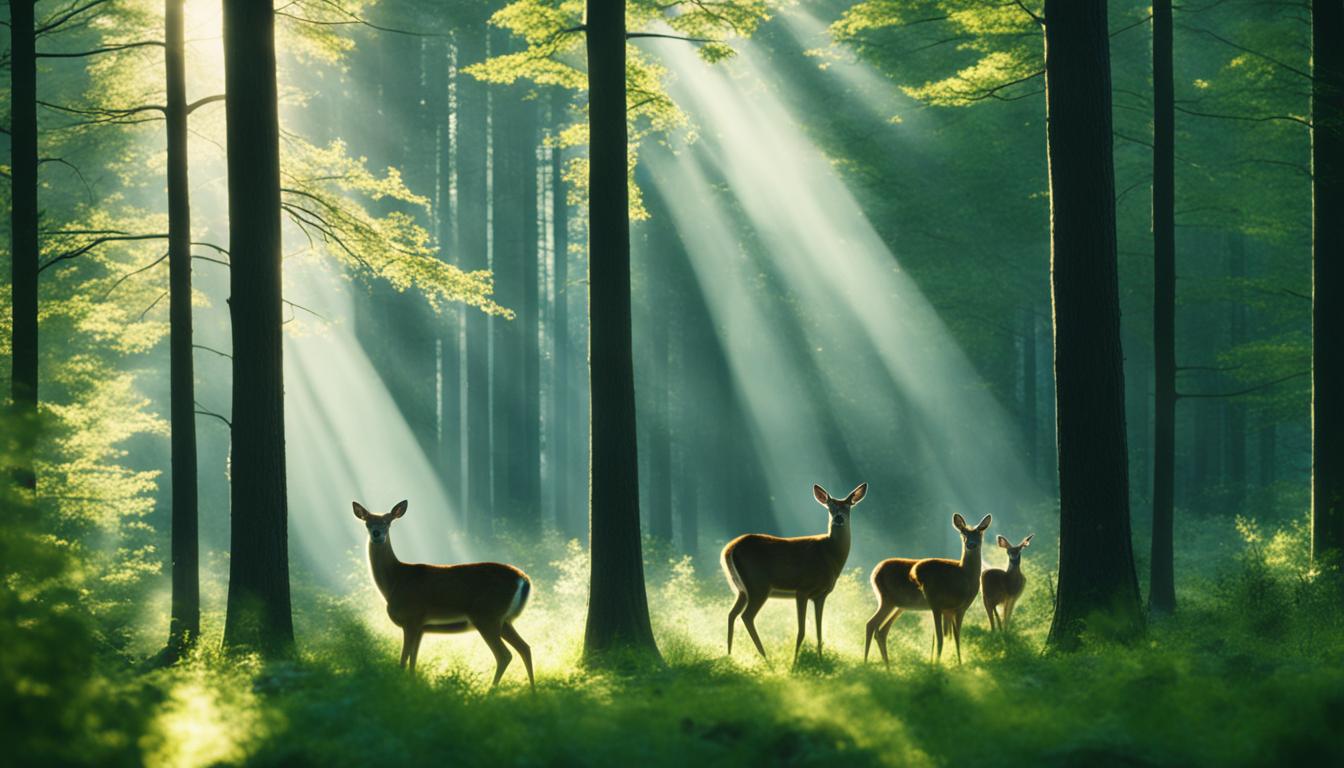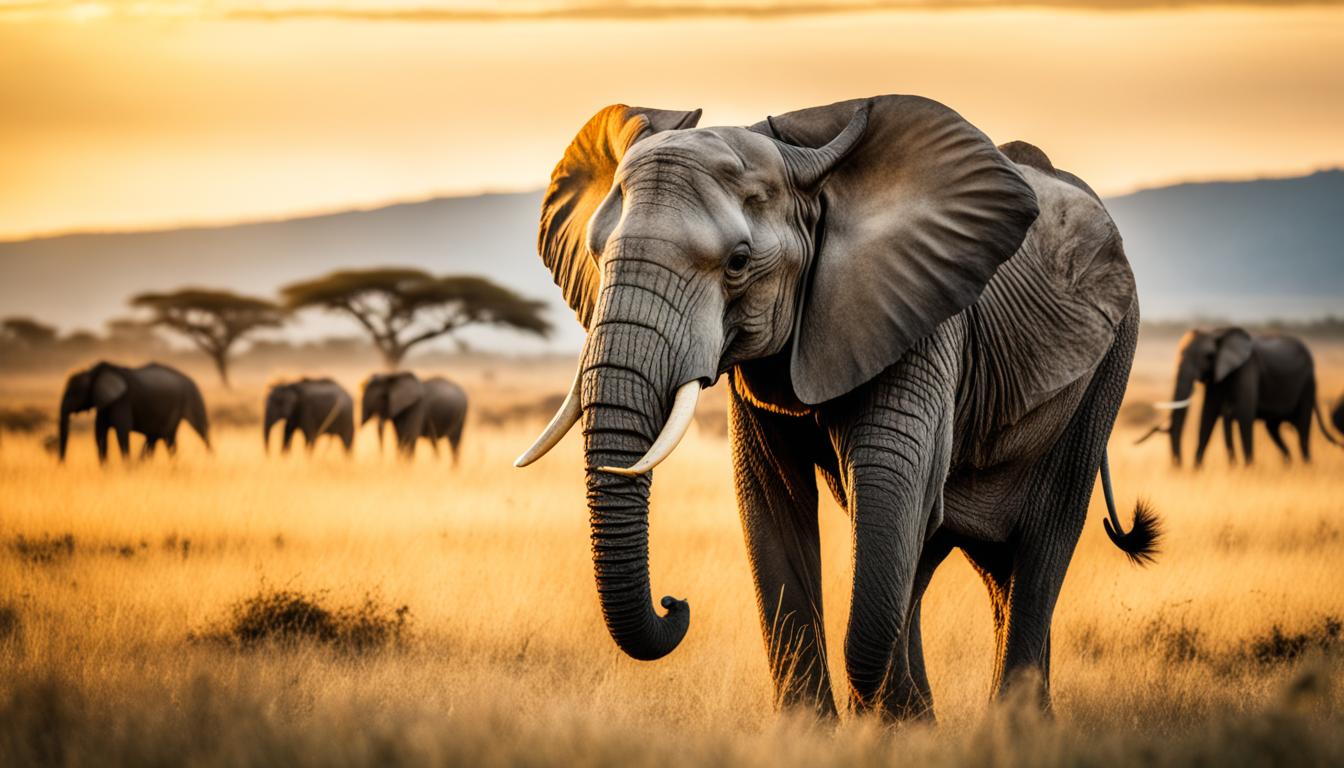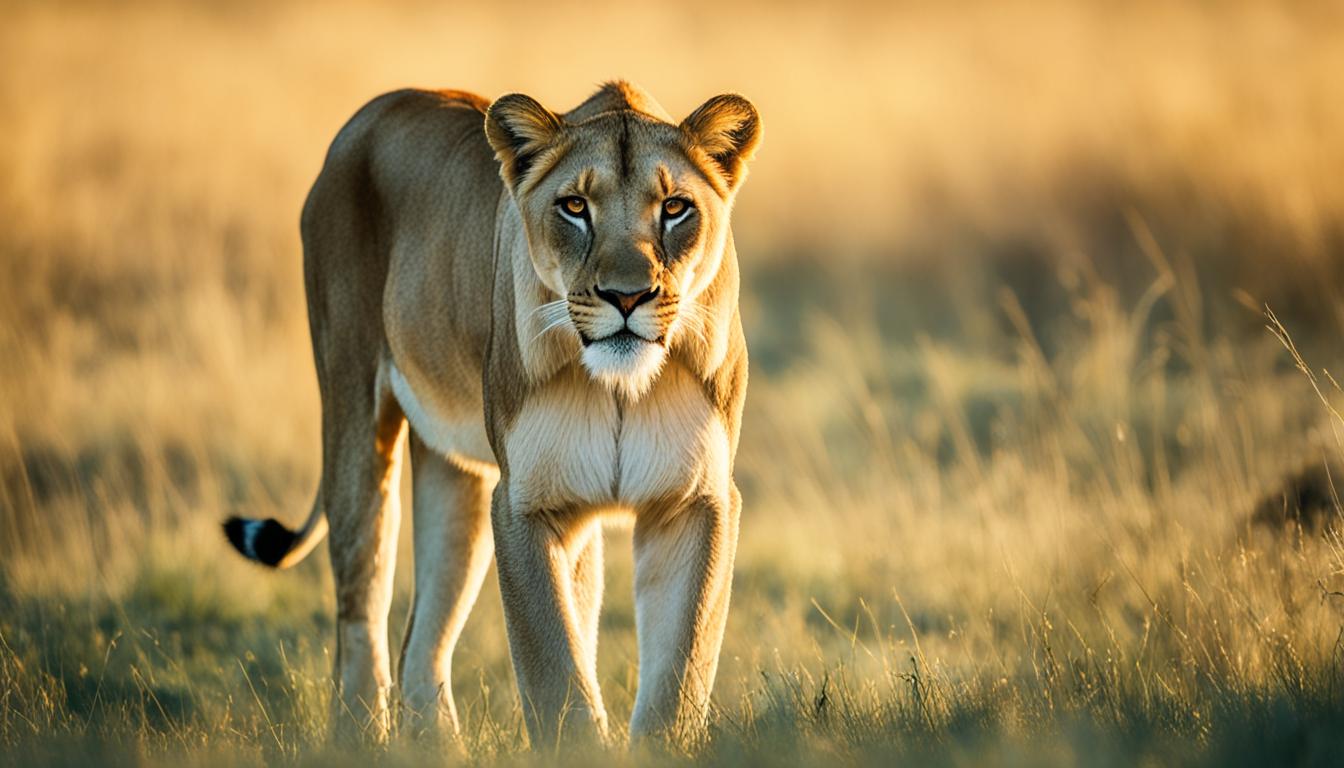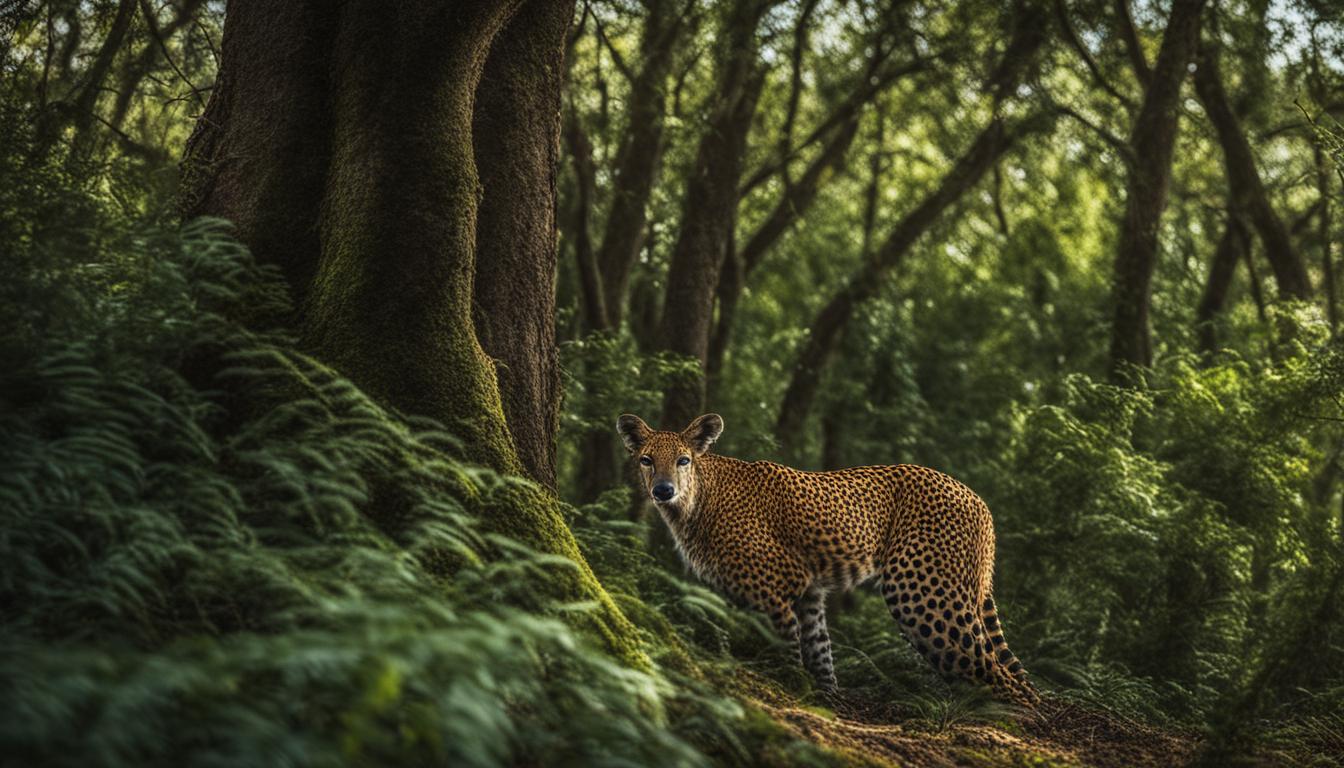At the heart of wildlife photography lies the thrill of capturing magnificent creatures in their natural habitats. From the lush forests to the arid deserts and the vibrant wetlands, nature’s beauty knows no bounds. In this article, we invite you to join us on an exploration of the art of wildlife photography in different environments. We will delve into the secrets of capturing the essence and diversity of wildlife in forests, deserts, and wetlands, providing you with expert tips and captivating stories along the way.
Key Takeaways:
- Wildlife photography takes you on a visual adventure through forests, deserts, and wetlands.
- Each environment offers unique opportunities and challenges for capturing stunning wildlife images.
- Expert tips and stories will help you hone your skills and enhance your photography techniques.
- Understanding animal behavior and using appropriate gear are key to successful wildlife photography.
- By following ethical practices, wildlife photographers can contribute to conservation efforts.
The Importance of Wetlands in Wildlife Photography
Wetlands are vital ecosystems that provide essential habitat for a variety of species. They support a diverse range of plants, birds, fishes, and amphibians, and they are particularly important for many migratory bird species. Wetlands also offer opportunities for wildlife photographers to capture unique images of these species in their natural habitats.
One of the key reasons why wetlands are important in wildlife photography is their ability to clean drinking water. Wetlands act as natural filters, removing pollutants and purifying water before it reaches our homes and communities. By preserving and showcasing the beauty of wetlands through photography, we can raise awareness of their importance in maintaining clean and healthy water systems.
Wetlands are not only picturesque landscapes; they play a crucial role in providing shelter during storms. Their unique topography and vegetation provide a buffer against surging waters, protecting nearby communities and the wildlife that depends on these habitats.
Wetlands are not just serene and beautiful; they are habitats of incredible diversity. They host a variety of ecosystems, such as marshes, swamps, and mangroves, which provide shelter, feeding grounds, and breeding sites for a wide range of species. By capturing stunning images of wetland wildlife, we can showcase the importance of these habitats in supporting both common and endangered species.
Understanding the importance of wetlands is crucial for wildlife photographers who want to capture captivating images of these environments and the creatures that inhabit them. By highlighting the beauty and significance of wetlands through conservation photography, we can inspire others to appreciate and protect these precious ecosystems.
| Species | Status |
|---|---|
| Red-cockaded Woodpecker | Endangered |
| Hooded Crane | Endangered |
| Bog Turtle | Threatened |
| Florida Panther | Endangered |
| Black-capped Vireo | Endangered |
Wildlife Photography in Forests
Forests are enchanting and diverse habitats that provide abundant opportunities for wildlife photography. In these lush ecosystems, photographers can capture the beauty of forest-dwelling wildlife, including majestic mammals like bears and deer, as well as vibrant birds and fascinating insects.
One of the unique aspects of forest photography is the play of light and shadows that filters through the canopy of trees. The dappled sunlight creates a magical atmosphere, adding depth and intrigue to your photographs. Use this natural lighting to your advantage, highlighting your subjects and creating captivating compositions.
When photographing wildlife in forests, it’s essential to be patient and observant. Many forest-dwelling species are elusive and well-camouflaged, blending seamlessly into their surroundings. Take your time to study their behavior and movements, and be ready to capture that perfect shot when the opportunity presents itself.
Aside from capturing individual wildlife subjects, forests also offer breathtaking opportunities for landscape photography. Use the grandeur of towering trees, carpets of wildflowers, and tranquil streams to create stunning compositions that showcase the natural beauty of the forest habitat.
To truly immerse yourself in forest photography, try exploring different forest types, such as evergreen, deciduous, or rainforests. Each forest presents its own unique characteristics and inhabitants, providing endless possibilities for capturing captivating images.
| Forest Photography Tips | Forest Wildlife Examples |
|---|---|
| 1. Study animal behavior for better anticipation | Bird landing on a branch |
| 2. Utilize natural lighting and shadows | Deer grazing in the forest |
| 3. Experiment with different angles and perspectives | Squirrel leaping from tree to tree |
| 4. Capture the interaction between wildlife and the forest environment | Butterfly pollinating a flower |
We are surrounded by the wonders of forest wildlife, waiting to be photographed. From the smallest insects to the largest mammals, the forest is a living canvas for photographers to capture and share the beauty of nature.

Wildlife Photography in Deserts
Deserts are harsh and challenging environments for both wildlife and photographers. However, they also offer unique photographic opportunities. Desert wildlife must adapt to extreme temperatures and limited water sources, making them resilient and fascinating subjects. Photographers can capture the striking contrast between the arid landscape and the resilient wildlife that calls the desert home. The sparse vegetation and vast open spaces of deserts also provide opportunities for capturing stunning landscape images with wildlife as the focal point.
Challenges of Desert Wildlife Photography
Photographing wildlife in deserts presents several challenges that photographers must overcome. The extreme temperatures can impact both equipment and photographers, requiring proper planning and preparation. Additionally, the limited water sources in deserts make it crucial to find watering holes or areas where animals are likely to gather.
Expert Tips for Desert Wildlife Photography
- Research the region and its wildlife: Understanding the behaviors and habitats of desert wildlife will help you anticipate their movements and increase your chances of capturing unique images.
- Be patient and observant: Deserts may initially seem devoid of life, but with patience and careful observation, you can discover the hidden wonders that await you. Look for animal tracks, burrows, and signs of activity.
- Opt for early morning or late afternoon sessions: The soft, warm light during these times enhances the colors and textures of both the landscape and the wildlife. Emphasize the golden hours to capture captivating images.
- Use a telephoto lens: Since wildlife in the desert can be elusive and tend to keep a distance, a telephoto lens will allow you to capture close-up shots without disturbing the animals.
“Desert wildlife photography is a test of endurance, patience, and adaptability. By embracing these challenges, photographers can capture remarkable images that showcase both the resilience of desert wildlife and the breathtaking beauty of these arid landscapes.” – Photographer Name
| Advantages | Disadvantages |
|---|---|
| Unique wildlife adaptations | Sparse vegetation and limited water sources |
| Dramatic contrast between wildlife and landscape | Extreme temperatures and harsh conditions |
| Opportunities for captivating landscape images | Elusive wildlife behavior |
Wildlife Photography in Wetlands
Wetlands, with their dynamic and diverse ecosystems, provide an ideal opportunity for capturing breathtaking wildlife photographs. These aquatic habitats are teeming with a wide range of species, making wetlands wildlife photography an exhilarating and rewarding experience. However, photographing wildlife in wetlands comes with unique challenges that require a deep understanding of the environment and its inhabitants.
One of the key challenges in wetlands wildlife photography is capturing subjects that are often in or around the water. Whether it’s a bird taking flight, a fish leaping out of the water, or an amphibian basking in the sun, being able to freeze these moments requires skill and precision. Furthermore, wetlands often have low-light conditions, making it necessary to adjust camera settings and use appropriate techniques to ensure well-exposed images without compromising the desired effect.
The reflections found in wetlands, along with the unique vegetation, provide photographers with the opportunity to create visually striking images. These visual elements add depth and interest to wildlife photographs, creating captivating compositions that highlight the beauty of the subject and its surroundings.
In wetlands wildlife photography, patience is key. As with any form of wildlife photography, waiting for the perfect moment to capture a specific behavior or interaction is crucial. Observing the behavior of wildlife in wetlands, understanding their movements and patterns, and being able to anticipate their actions will greatly enhance the chances of capturing truly remarkable shots.
“Wetlands wildlife photography allows us to witness the magic of these vibrant ecosystems and tell the stories of the species that call them home. It’s a chance to showcase the unique beauty and importance of wetlands in a world where conservation is more crucial than ever.”
The following table highlights some of the key tips and techniques for successful wildlife photography in wetlands:
| Tips and Techniques for Wildlife Photography in Wetlands |
|---|
| 1. Familiarize yourself with the wetland environment and the behavior of the wildlife species you wish to photograph. |
| 2. Use a telephoto lens to capture close-up shots of wildlife without disturbing their natural behavior. |
| 3. Adjust your camera settings to compensate for low-light conditions, such as using a higher ISO or wider aperture. |
| 4. Experiment with different angles and perspectives to capture unique compositions that showcase the beauty of wetlands. |
| 5. Incorporate the reflections and unique vegetation present in wetlands to add depth and interest to your photographs. |
| 6. Be patient and observant, allowing wildlife to interact naturally within their environment, and capturing their behaviors authentically. |
With the right techniques and a deep appreciation for the beauty of wetlands, wildlife photographers can create stunning and impactful images that bring attention to the importance of these vital habitats and the diverse species that depend on them.
Continue reading to learn more about the art of wildlife photography in different environments, including forests and deserts.
Tips and Techniques for Wildlife Photography
Capturing stunning wildlife images requires skill, patience, and a good understanding of animal behavior. Here are some tips and techniques to help wildlife photographers improve their craft:
- Research and Plan: Learn about the habitats and behaviors of the wildlife you want to photograph, and plan your photography outings accordingly.
- Use Appropriate Gear: Invest in a telephoto lens to get close-up shots of distant wildlife. Tripods or monopods can help stabilize your camera and reduce camera shake.
- Be Patient: Wildlife photography often requires waiting for the perfect moment to capture a specific behavior or interaction. Patience is key.
- Consider Composition: Pay attention to the composition of your images, using elements such as leading lines, the rule of thirds, and negative space to create visually appealing photographs.
- Take Advantage of Natural Light: Use the golden hours of early morning and late afternoon when the natural light is soft and warm, creating beautiful images with a pleasing glow.
| Tip | Technique |
|---|---|
| Research and Plan | Learn about the habitats and behaviors of the wildlife you want to photograph, and plan your photography outings accordingly. |
| Use Appropriate Gear | Invest in a telephoto lens to get close-up shots of distant wildlife. Tripods or monopods can help stabilize your camera and reduce camera shake. |
| Be Patient | Wildlife photography often requires waiting for the perfect moment to capture a specific behavior or interaction. Patience is key. |
| Consider Composition | Pay attention to the composition of your images, using elements such as leading lines, the rule of thirds, and negative space to create visually appealing photographs. |
| Take Advantage of Natural Light | Use the golden hours of early morning and late afternoon when the natural light is soft and warm, creating beautiful images with a pleasing glow. |

Wildlife Photography Ethics and Conservation
As wildlife photographers, we have a responsibility to uphold ethical practices and contribute to the conservation of the species and habitats we photograph. By following these principles, we can capture stunning wildlife images while also ensuring the well-being of the subjects and the preservation of their environments.
One of the core principles of wildlife photography ethics is to avoid disturbing or stressing the animals. It is essential to respect their natural behaviors and avoid altering or manipulating the environment solely for the sake of a photograph. This approach allows us to capture the true essence of wildlife while minimizing our impact on their lives.
Conservation photography is a powerful tool for raising awareness and inspiring action for the protection of wildlife and their habitats. Through our images, we have the opportunity to tell stories that advocate for conservation and play a vital role in preserving nature. It is through this combination of art and storytelling that we can make a positive impact on the world.
“Conservation photography aims to raise awareness and inspire action for the protection of wildlife and their habitats.”
By showcasing the beauty, diversity, and fragility of nature, wildlife photographers can evoke emotions and create a connection between viewers and the natural world. These images have the power to ignite a sense of responsibility and drive individuals and communities to take action to protect our planet.
The Role of Wildlife Photographers in Conservation
Wildlife photographers play a significant role in supporting conservation efforts. Through partnerships with environmental organizations, we can contribute our images to campaigns, books, and exhibitions that promote the protection of species and their habitats. These collaborations raise awareness, educate the public, and provide tangible support to conservation initiatives.
- Photographing endangered species and their habitats helps raise the alarm about their plight and the urgent need for conservation action.
- Documenting success stories can inspire others by showcasing the positive impact of conservation efforts and the resilience of wildlife.
- Contributing to scientific research by documenting rare or elusive species and behavior offers valuable insights into animal behavior and ecology, aiding in their conservation.
Ethics and Conservation: A Collective Effort
Protecting wildlife and their habitats is not solely the responsibility of wildlife photographers. It requires a collective effort involving governments, organizations, communities, and individuals. By responsibly practicing wildlife photography and advocating for conservation, we contribute to a greater cause.
Conservation photography is not just about capturing beautiful images; it’s about raising awareness, supporting conservation efforts, and inspiring a collective commitment to safeguarding the natural world for future generations.
Let us continue to use our passion for wildlife photography to make a positive impact. Together, we can help preserve the wonders of nature and ensure that future generations have the same opportunity to marvel at the beauty of wildlife.
The Role of Wildlife Photography in Nature Conservation
Wildlife photography has a significant impact on promoting nature conservation awareness. Through our captivating images, we have the power to showcase the breathtaking beauty and incredible diversity of wildlife, captivating the hearts and minds of the public. Each photograph offers a unique glimpse into the fascinating lives of animals and helps create a connection between people and the natural world.
As wildlife photographers, we often collaborate with conservation organizations, lending our images to their campaigns, books, and exhibitions. By doing so, we contribute to the promotion of wildlife protection and habitat preservation. Our photographs become powerful tools in raising public interest and support for conservation efforts, inspiring action that can make a real difference.
Driving Conservation Action
“In the end, we conserve only what we love; we love only what we understand; and we understand only what we are taught.” – Baba Dioum
Through the lens of our cameras, we showcase the immense value of wildlife and the urgent need to protect these precious species. Our photographs capture both the fragile beauty of nature and the pressing threats it faces, creating a sense of urgency that drives conservation action.
The Photographer’s Commitment
As wildlife photographers, we understand the responsibility that comes with our craft. We strive to capture images without disrupting or stressing the animals, always respecting their natural behaviors and habitats. Our commitment to ethical photography ensures that our actions do not harm the very subjects we seek to preserve.
The Impact of Conservation Photography
The power of wildlife photography lies in its ability to evoke emotions and inspire change. Our photographs have the potential to kindle a sense of wonder and awe, igniting a passion for conservation in the hearts of viewers. By combining artistry and science, we illustrate the intricate web of life and the interconnectedness of our world.
| Role of Wildlife Photography in Conservation | Impact |
|---|---|
| Raising awareness and appreciation | Audiences gain a deeper understanding of the importance of preserving wildlife and their habitats |
| Inspiring action | Viewers are motivated to contribute to conservation efforts and make informed choices |
| Collaboration with conservation organizations | Photographers contribute their images to campaigns, books, and exhibitions that promote wildlife protection |
| Education and advocacy | Photographs serve as visual storytelling tools, educating and engaging the public on conservation issues |
By harnessing the power of visual storytelling, we have the ability to create lasting change and safeguard the natural world for future generations.
The Adventure of Wildlife Photography
Wildlife photography is not just about capturing visually stunning images; it’s also about the thrilling adventure and extraordinary stories that unfold behind each photograph. As photographers, we often find ourselves venturing into remote and challenging locations, dedicating countless hours, days, or even months to capture that elusive moment or behavior that will truly capture the essence of wildlife.
These exhilarating adventures take us deep into nature’s embrace, allowing us to connect with wildlife on a profound level. We witness breathtaking scenes, such as the captivating dance of a bird in flight, the intense stare of a predator, or the tender interaction between a mother and her offspring. These moments become etched in our memory, forever reminding us of the beauty and wonder of the natural world.
The Thrill of Immersion
Immersing ourselves in nature is a truly transformative experience. We walk through dense forests, where sunlight filters through the canopy, illuminating the vibrant colors of the flora and fauna. We traverse expansive deserts, where the golden hues of the sand create a stunning backdrop for the resilient creatures that call these harsh environments home. And we navigate through serene wetlands, where the serene waters mirror the grace and elegance of the wildlife that dwells within.
Connecting with Wildlife
Through our lens, we establish a connection with the animals we photograph. We observe their behaviors, their interactions, and their unique adaptations to their habitats. We witness the raw power of a predator hunting its prey, the playful antics of young animals, or the graceful movements of birds in their mating rituals.
Witnessing Natural Phenomena
As wildlife photographers, we are privileged to witness extraordinary natural phenomena. We may capture the powerful migration of thousands of birds, their synchronized flight creating patterns that seem almost surreal. We may witness the breathtaking display of bioluminescence in a dark forest, where tiny organisms light up the night like stars, creating a mystical atmosphere.
Sharing Our Experiences
Through our photographs, we have the power to transport others into the heart of our adventures. We can evoke emotions, inspire awe, and ignite a sense of wonder about the natural world. By sharing our experiences, we aim to foster a deeper appreciation for nature and encourage others to take action in preserving and protecting these irreplaceable environments.
| Adventure of Wildlife Photography | Benefits |
|---|---|
| Thrilling expeditions to remote locations | Opportunities to capture unique moments and behaviors |
| Deep connection with nature | Greater appreciation for the beauty and wonder of the natural world |
| Witnessing extraordinary animal behaviors | Understanding and admiration for wildlife’s resilience |
| Experiencing awe-inspiring natural phenomena | Deepening our understanding of the Earth’s extraordinary dynamics |
| Sharing adventures through photography | Inspiring others to appreciate and protect nature |
Conclusion
Wildlife photography in forests, deserts, and wetlands offers a thrilling journey for photographers. Each environment presents its own unique set of challenges and opportunities, making every photo shoot an adventure in itself. The diverse habitats, species, and photographic possibilities found in these environments showcase the magnificent beauty and complexity of wildlife.
By adhering to ethical practices, such as respecting animal behavior and not disturbing the natural environment, photographers can capture stunning images while also contributing to conservation efforts. A deep understanding of animal behavior and the use of appropriate techniques and gear are key to capturing breathtaking wildlife photographs.
Wildlife photography serves as a powerful medium for connecting with nature and inspiring others to appreciate and protect the natural world. Through their lens, photographers capture moments that tell stories and raise awareness of the importance of conservation. By sharing their experiences, photographers can ignite a passion in others to value and preserve the rich biodiversity found in forests, deserts, and wetlands.
So, grab your camera, immerse yourself in nature, and embark on your own wildlife photography adventure. Capture the beauty of wildlife in different environments and help preserve our planet’s precious ecosystems. Together, let’s celebrate and protect the wonders of the natural world. Happy shooting!
FAQ
What are some tips for wildlife photography in forests?
Research the habitats and behaviors of the wildlife you want to photograph, use appropriate gear such as a telephoto lens, be patient and wait for the right moment, and consider composition and natural lighting.
What are some unique challenges of wildlife photography in deserts?
Deserts are harsh environments with extreme temperatures and limited water sources, making it challenging for both wildlife and photographers. However, opportunities arise to capture the resilient wildlife and the striking contrast with the arid landscape.
How can wetlands contribute to wildlife photography?
Wetlands are diverse habitats that support a wide range of plant and animal species, offering unique opportunities to capture images of wildlife in their natural habitats. They provide unique lighting conditions, reflections, and interesting vegetation for photographers.
What are some essential tips and techniques for wildlife photography?
Research and plan your photography outings, use appropriate gear, be patient and wait for the perfect moment, consider composition and natural lighting, and take advantage of the golden hours of early morning and late afternoon.
How can wildlife photographers contribute to conservation efforts?
Wildlife photographers should follow ethical practices, respect natural behaviors, and not alter or manipulate the environment for a photograph. Conservation photography can raise awareness and inspire action by showcasing the value of wildlife and the threats they face.
What is the role of wildlife photography in nature conservation?
Wildlife photography helps raise awareness about the importance of nature conservation by showcasing the beauty and diversity of wildlife, and by partnering with conservation organizations to contribute to campaigns, books, and exhibitions that promote species and habitat protection.
How can wildlife photography be an adventure?
Wildlife photographers often embark on expeditions to remote locations, dedicating time and effort to capture specific moments or behaviors. These adventures offer opportunities to immerse oneself in nature, witness incredible natural phenomena, and share experiences through photographs.
How Can Post-Processing Enhance the Wildlife Captured in Different Environments?
Post-processing techniques play a crucial role in enhancing wildlife photographs nature captured in different environments. Through careful editing, photographers can adjust colors, contrast, and sharpness to bring out the true beauty of the wildlife and its natural surroundings, creating stunning and impactful images that truly capture the essence of the moment.




